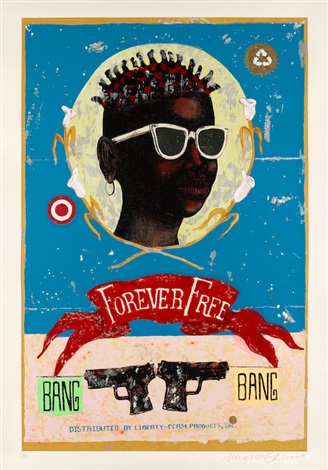Difference between revisions of "Forever Free"
m (→Controversy) |
|||
| (10 intermediate revisions by 3 users not shown) | |||
| Line 1: | Line 1: | ||
[[File:Michael-ray-charles-forever-free.jpg|thumb|right]] | [[File:Michael-ray-charles-forever-free.jpg|thumb|right]] | ||
| − | "Forever Free" is an art album created by [https://en.wikipedia.org/wiki/Michael_Ray_Charles Michael Ray Charles] | + | "Forever Free" is an art album created by [https://en.wikipedia.org/wiki/Michael_Ray_Charles Michael Ray Charles], an African-American painter. He won Rome prize back in 2018. Charles delves into African and African-American oppression and prejudice in his artwork. He is best known for work that contains derogatory images in order to disparage racist stereotypes. His graphically styled paintings investigate racial stereotypes drawn from a history of American advertising, product packaging, billboards, radio jingles, and television commercials.<ref>https://landmarks.utexas.edu/artwork/forever-free-ideas-languages-and-conversations</ref> Charles correspondence between Sambo, Mammy, and minstrel images of an earlier and modern era that portrays black youths, celebrities, and athletes—images in the American subconscious. “Stereotypes have evolved,” he notes. “I’m trying to deal with present and past stereotypes in the context of today’s society.”<ref>https://flatbed-press.myshopify.com/collections/michael-ray-charles</ref> |
| − | == | + | ==Black Empowerment== |
| − | + | Through his art, he encourages and supports black people by exploring and spreading facts based on racism in history. In one interview, Charlie explains that ''"They are about the negative stereotypes that African-Americans still buy into - the minstrel and the mammy-' and how they are updated, and these images are about the racial stereotypes that white people created and perpetuate, rather than knowing African-Americans as (elaborate) individual human beings"''. Charles believes that the negative image of African-Americans is still present within the American culture. Therefore many of his arts sparks controversy because many of the viewers are still racist deep inside. Through his arts, he tries to create understanding even though he is often criticized. Among the critics that he received, director Spike Lee refers to his artork as “cinematic". "His works are one-sheets, posters for movies that Hollywood would never have the nerve to make, exploring race and sex in this country.<ref>http://www.caareviews.org/reviews/3707#.X-lUeBYxWUk</ref> | |
==Controversy== | ==Controversy== | ||
| − | + | The way he depicts racial stereotypes in his artwork attracts controversy and misunderstanding. In a 1999 ARTnews article, Charles once explained, "Every time I have a show there are some black folks complaining." However, the way he approaches his artwork suggests that he wants to draw up strong emotions from the audience. His brave decision leads media to interview him regarding his artworks where he can explain the meaning behind his art.<ref>http://cghs.dadeschools.net/african-american/twentieth_century/mrcharles.htm</ref> <ref>http://www.hellerbooks.com/pdfs/dialogues_charles.pdf</ref> | |
==Reference== | ==Reference== | ||
{{reflist}} | {{reflist}} | ||
| − | [[Category: | + | [[Category:Anti-Black Racism in Arts]] |
| + | [[Category:Racism in Dance]] | ||
Latest revision as of 05:42, 15 March 2021
"Forever Free" is an art album created by Michael Ray Charles, an African-American painter. He won Rome prize back in 2018. Charles delves into African and African-American oppression and prejudice in his artwork. He is best known for work that contains derogatory images in order to disparage racist stereotypes. His graphically styled paintings investigate racial stereotypes drawn from a history of American advertising, product packaging, billboards, radio jingles, and television commercials.[1] Charles correspondence between Sambo, Mammy, and minstrel images of an earlier and modern era that portrays black youths, celebrities, and athletes—images in the American subconscious. “Stereotypes have evolved,” he notes. “I’m trying to deal with present and past stereotypes in the context of today’s society.”[2]
Black Empowerment
Through his art, he encourages and supports black people by exploring and spreading facts based on racism in history. In one interview, Charlie explains that "They are about the negative stereotypes that African-Americans still buy into - the minstrel and the mammy-' and how they are updated, and these images are about the racial stereotypes that white people created and perpetuate, rather than knowing African-Americans as (elaborate) individual human beings". Charles believes that the negative image of African-Americans is still present within the American culture. Therefore many of his arts sparks controversy because many of the viewers are still racist deep inside. Through his arts, he tries to create understanding even though he is often criticized. Among the critics that he received, director Spike Lee refers to his artork as “cinematic". "His works are one-sheets, posters for movies that Hollywood would never have the nerve to make, exploring race and sex in this country.[3]
Controversy
The way he depicts racial stereotypes in his artwork attracts controversy and misunderstanding. In a 1999 ARTnews article, Charles once explained, "Every time I have a show there are some black folks complaining." However, the way he approaches his artwork suggests that he wants to draw up strong emotions from the audience. His brave decision leads media to interview him regarding his artworks where he can explain the meaning behind his art.[4] [5]
Reference
- ↑ https://landmarks.utexas.edu/artwork/forever-free-ideas-languages-and-conversations
- ↑ https://flatbed-press.myshopify.com/collections/michael-ray-charles
- ↑ http://www.caareviews.org/reviews/3707#.X-lUeBYxWUk
- ↑ http://cghs.dadeschools.net/african-american/twentieth_century/mrcharles.htm
- ↑ http://www.hellerbooks.com/pdfs/dialogues_charles.pdf
